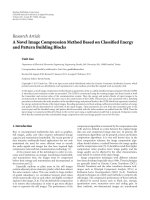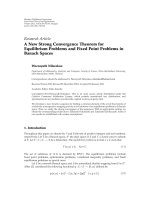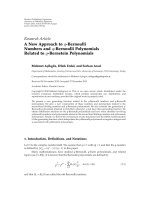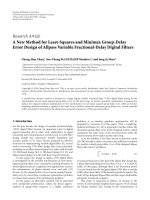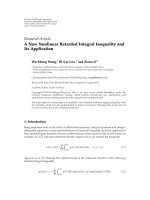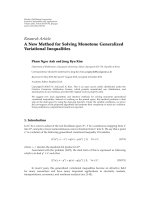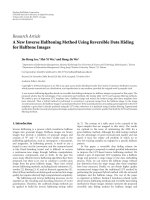Báo cáo hóa học: " Research Article A New Inverse Halftoning Method Using Reversible Data Hiding for Halftone Images" docx
Bạn đang xem bản rút gọn của tài liệu. Xem và tải ngay bản đầy đủ của tài liệu tại đây (8.52 MB, 13 trang )
Hindawi Publishing Corporation
EURASIP Journal on Advances in Signal Pr ocessing
Volume 2010, Article ID 430235, 13 pages
doi:10.1155/2010/430235
Research Ar ticle
A New Inverse Halftoning Method Using Reversible Data Hiding
for Halftone Images
Jia-Hong Lee,
1
Mei-Yi Wu,
2
and Hong-Jie Wu
1
1
Department of Information Management, National Kaohsiung First University of Science and Technology, Kaohsiung 811, Taiwan
2
Department of Information Management, Chang Jung Christian University, Tainan 711, Taiwan
Correspondence should be addressed to Mei-Yi Wu,
Received 26 December 2009; Revised 28 July 2010; Accepted 5 October 2010
Academic Editor: Alex Kot
Copyright © 2010 Jia-Hong Lee et al. This is an open access article distributed under the Creative Commons Attribution License,
which permits unrestricted use, distribution, and reproduction in any medium, provided the original work is properly cited.
A new inverse halftoning algorithm based on reversible data hiding techniques for halftone images is proposed in this paper. The
proposed scheme has the advantages of two commonly used methods, the lookup table (LUT) and Gaussian filtering methods.
We embed a part of important LUT templates into a halftone image and restore the lossless image after these templates have
been extracted. Then a hybrid method is performed to re construct a grayscale image from the halftone image. In the image
reconstruction process, the halftone image is scanned pixel by pixel. If the scanned pattern surrounding a pixel appeared in the LUT
templates, a gray value is directly predicted using the LUT value; otherwise, it is predicted using Gaussian filtering. Experimental
results show that the reconstructed grayscale images using the proposed scheme own better quality than both the LUT and Gaussian
filtering methods.
1. Introduction
Inverse halftoning is a process which transforms halftone
images into grayscale images. Halftone images are binary
images that provide a rendition of grayscale images and
consists of “0” and “1”. It has been widely used in the
publishing applications, such as newspapers, e-documents,
and magazines. In halftoning process, it needs to use a
kernel to carry out the conversion, and the common kernel
is like Floyd-Steinberg kernel and is difficult to recover
a continuous-tone image through halftone manipulation,
conversion, compression, and so forth. In the past few
years, many efficient inverse halftoning algorithms have been
proposed, but there is no way to construct a perfect gray
image from the given halftone image. There exist several
inverse halftoning methods, including kernel estimation [1],
wavelet [2], filtering [3, 4], and set theoretic approaches [5].
Most of these methods can obtain good reconstruction image
quality but require relatively high computational complexity.
The halftoning and inverse halftoning processes can be
regarded as the encoding and decoding processes of vector
quantization. Therefore, the codebook design methods can
be applied to build the inverse halftoning lookup tables
[6, 7]. The content of a table entry is t he centroid of the
input samples that are mapped to this entry. The results
are optimal in the sense of minimizing the MSE for a
given halftone method. Although the table lookup method
has the advantages of good reconstructed quality and fast
speed, it faces the empty cell problem in which no or
very few training samples are mapped to a specific halftone
pattern.
In this paper, a reversible data hiding scheme for
halftone images is proposed to embed specified information
to improve the LUT-based inverse halftoning method. We
embed a part of important LUT templates into a halftone
image and generate a stego image in the data embedding
process. Then, we can restore the halftone image without
any distortion from the stego image after these templates
have been extracted. Finally, we can obtain higher quality
reconstructed images than the traditional LUT method by
performingtheproposedhybridmethodwiththeextracted
templates and the halftone image. The rest of the paper
is organized as follows. Section 2 introduces related works
about inverse halftoning methods and reversible data hiding
methods for binary images. Section 3 presents the proposed
reversible data hiding method for halftone images and
2 EURASIP Journal on Advances in Signal Processing
theproposedhybridmethodforinversehalftoning.Section 4
shows the experimental results and discussions, and the final
section summarizes this paper.
2. Related Works
In this section, we introduce the methods which are related
to inverse halftoning techniques including LUT-based and
the Gaussian filtering methods. In addition, recently used
reversible data hiding techniques for binary images are also
introduced.
2.1. LUT-Based Method. The LUT-based method includes
two procedures: the LUT buildup and the LUT-based inverse
halftoning (LIH) procedures. The LUT buildup procedure is
to build the LUT information by sc anning selected grayscale
images and their corresponding halftone images with a 3
× 3
and 4
× 4 template. Figure 1 shows the 3 × 3and4×
4 templates with symbol X denoting the estimated pixel,
respectively. Template is used as a sliding window to build
up the LUT. In the LIH procedure, a grayscale image can
be reconstructed from the given halftone image using the
LUT information. The LUT information contains a set of
pairs of binary pattern and its corresponding estimated gray
value. Assume that there are L training image pair sets and
{(O
i
, H
i
) | 1 ≤ i ≤ L} represents the ith pair, where O
i
denotes the ith original image and H
i
the corresponding
halftone image of O
i
. The LUT buildup and LIH procedures
using 4
× 4templateF are described as follows.
Procedure LUT Buildup
Step 1. Let arrays LUT[ ] and N[ ] be zero as the initial
values. LUT[ ] is used to record the mapped gray value
corresponding to a specific binary template with index I
which appears in the input halftone image, and N[]isused
to store the occurrence frequency of this specific binary
template in the halftone image. Select L training grayscale
images, and generate their corresponding halftone images,
respectively .
Step 2. Select one image from the L training grayscale
images. Scan the selected image and its corresponding
halftone image in raster order with the template F.Theindex
I for a pixel X can be calculated using (1), where k represents
different locations on the template F. Since there are totally
16 locations on the template F,thevalueofI ranges from 0 to
65535. Then, the sum of the template occurrence frequencies
and the sum of the gray values on the image pixel X can be
computed as (2):
I
=
15
k=0
2
K
P
k
,(1)
N
[
I
]
= N
[
I
]
+1,
LUT
[
I
]
= LUT
[
I
]
+X.
(2)
Step 3. Repeat Step 2,untilallL images are selected.
Step 4. The predicted gray value for a specified 4
× 4pattern
with indexed I can be computed as
LUT
[
I
]
=
LUT
[
I
]
N
[
I
]
. (3)
Figure 2(a) shows an example to build LUT by performing
Step 2 of LUT buildup algorithm.
Procedure LIH
Step 1. Perform the above-mentioned LUT buildup algo-
rithm to build LUT.
Step 2. Scan a halftone image in raster order with template F,
and compute the template index I using (1). The estimated
gray value on pixel X can be obtained and denoted as X
=
LUT[I].
Step 3. Output the estimated grayscale image.
Figure 2(b) shows an example to build LUT by perform-
ing of LIH algorithm.
Note that, some binary patterns in the input halftone
image may not exist in the training images. In this situation,
we will apply filters to estimate the mean gray pixel.
Though the LUT-based inverse h alftoning method is
easily implemented, there exists a disadvantage of this
method, the constructed LUT information must be sent to
the receiver.
2.2. Gaussian Filtering Method. Gaussian filtering is a
smoothing algorithm for images. Equation (4) denotes a
2D Gaussian function, and σ is the standard deviation of
a Gaussian distribution. In the implementation of inverse
halftoning using Gaussian filtering, the binary pixel value
0 and 1 in the input halftone image will be regarded as
0 and 255, respectively. A weight mask with specified size
andcontentsshouldbedeterminedaccordingtotheuse
of Gaussian distribution with parameter σ.Intheinverse
halftoning process, the halftone image is scanned pixel by
pixel in a raster order by moving the sliding mask. The output
gray value on the corresponding central pixel of the mask is
estimated v ia the summation of the weight value on the mask
content multiplying by the binary values on the neighboring
pixels. If the value of σ is larger, the resulting image will
be more smoothing. In the inverse halftoning process using
Gaussian filtering, the following equation of 2D Gaussian
distribution is generally used to determine the mask:
G
x, y
=
1
2πσ
2
e
−(x
2
+y
2
)/2σ
2
. (4)
2.3. Reversible Data Hiding for Binary Images. Reversible
data hiding can embed secret message in a reversible way.
Relatively large amounts of secret data are embedded into
a cover image so that the decoder can extract the hidden
secret data and restore the original cover image without
any distortion. Recently, a boundary-based PWLC method
has been presented [8]. This method defines the same
EURASIP Journal on Advances in Sig nal Processing 3
P
0
P
1
P
2
P
3
P
4
P
5
P
6
P
7
P
8
P
0
P
1
P
2
P
3
P
4
P
5
P
6
P
7
P
8
P
9
P
10
P
11
P
12
P
13
P
14
P
15
XX
Figure 1: The 3 × 3and4× 4 templates with symbol X denoting the estimated pixel, respectively.
4 × 4 halftone pattern
Original gray image
Halftone image
X: predicted gray value
X
(a) LUT buildup
23459 50
LUT T able
Halftone image Predicted gray image
Halftone pattern
X
Predicted X value
(b) LUT-based inverse halftoning
Figure 2: LUT-based method includes two procedures (a) LUT Buildup (b) LUT-based inv erse halftoning (LIH).
continuous 6 edge pixels as an embeddable block through
searching for binary image edges. And then one can embed
data in the pair of the third and fourth edge pixels. A
reversible data hiding method for error-diffused halftone
images is proposed [9]. This method employs statistics
feature of pixel block patterns to embed data and utilizes
the HVS characteristics to reduce t he introduced visual
distortion. The method is suitable for the applications, where
the content accuracy of the original halftone image must
be guaranteed, and it is easily extended to the field of
halftone image authentication. However, these two methods
have a drawback that the capacity of data hiding is still
limited.
3. Proposed Method
The proposed inv erse halftoning method based on reversible
data hiding techniques can be divided into two phases: the
embedding process and the extracting process. Figure 3(a)
shows the diagram of the proposed method. In the embed-
ding process, a grayscale image is transferred into a halftone
image by error diffusion process. Then pattern selection is
performed to determine the pattern pairs for the use in
reversible data hiding. Meanwhile, a part of LU T templates
are selected to keep high quality of recovery images in
the reconstruction process. These templates along with the
pattern pairs will be encoded in bit streams and embedded
4 EURASIP Journal on Advances in Signal Processing
Halftone image
Stego halftone image
1. Halftoning by
error diffusion
1. Extract data
2. Reconstruct
original halftone
3. Reconstruct
Embedding operation
Extracting operation
Pattern pairs
Predicted image
2. Pattern matching
4. Reversible data hiding
Pattern pairs
image
Grayscale image
grayscale image
Selected LUT templates
3. LUT template selection
LUT templates
(a)
00
0
00
0
0
0
0
0
0
0
0
0
0
0
0
0
0
0
0
0
0
1
111
0
0
0
0
0
1
1
0
0
1
1
1
1
1
1
1
1
1
1
11
1
1
0
1
1
1
1
1
1
1
0
0
0
1
1
1
1
1
1
1
Embed“011”
0
0
0
0
(b)
Figure 3: The embedding and extracting diagram and an example for the proposed method: (a) the embedding and extracting diagram of
proposed method, (b) an example to illustrate the process of data embedding using pattern substitution.
Figure 4: Bad human visual effects caused by pattern substitution during the data embedding process.
TC
PH
0
PL
0
PH
TC−1
PL
TC−1
Figure 5: The secret header of SH.
into the halftone image. The data embedding operation
is performed based on pattern substitution. In the data
extracting process, the pattern pairs and LUT templates are
first extracted. The halftone image can be losslessly restored
after the data extraction. Finally, we can reconstruct a good
quality grayscale image from the halftone one with the aid of
LUT templates. The proposed scheme has the advantages of
two commonly used methods, the lookup table (LUT) and
Gaussian filtering methods. We embed a part of important
LUT templates into a halftone image and restore the lossless
image after these templates had b een extracted.
3.1. Data Hiding with Pattern Substitut ion for Halftone
Images. The proposed method of reversible halftone data
hiding technique uses pattern substitution method to embed
and extract data into halftone images. The original image is
partitioned into a set of nonoverlapping 3
× 3blocks.There
are totally 2
9
different patterns. Therefore, each pattern is
uniquely associated with an integer in the range of 0 to 511.
In most cases, many patterns never appear in an image.
EURASIP Journal on Advances in Sig nal Processing 5
0
0
0
0
0
0
0
0
1
1
0
0
11
1
1
170
155
160
15
10
Halftoning
Original grayscale image
Halftone image
Predicted by LUT
by Gaussian filteringpredicted
Figure 6: An example for the comparison of image quality loss using two different methods.
Grayscale image Halftone image Gaussian filtering Predict image
Construct LUT template
T and temple F
Predict image
LUT entry selection
Figure 7: The flowchart of LUT entry selection.
In this study, all patterns are c lassified into two groups,
used and unused. For each used pattern A,anunusedpattern
B, its content is the most closest to pattern A, will be selected
to form a pair for data embedding. In the data embedding
process, the original halftone image is partitioned into a
group of 3
× 3 nonoverlapping patterns. Then, any pattern
p on the halftone image with the same content of A will be
selected to embed 1-bit data. If a data bit “0” is embedded
on p, then the content of p remains as A.Ifadatabit“1”
is embedded on p, then the content of p is updated as the
content of pattern B.Thisschemeworksbecausepatterns
A, B look similar. In data extraction process, the embedded
message is obtained depending on the patterns A, B when the
test image is scanned. For example, assume that the highest
frequent pattern in the image is PH
= 010, 011, 011 and its
corresponding unused pattern is PL
= 010, 001, 001. We can
embed three secret data bits (e.g., 011) into the following
6
× 6 image block with t he proposed pattern substitution
method. The image is firstly divided into four nonoverlapped
3
× 3 patterns, and these patterns are scanned horizontally
from top to buttom. If the content of the pattern PH is
encountered, then check the bit value which is currently
embedded.Ifthebitvalueis“0,”thenkeepthecontent
as PH. If the value is “1,” then we replace PH with the
PL pattern. This example of data embedding is shown in
Figure 3(b).
To achieve a higher capacity of embedding data, more
pattern pairs should be determined, whose steps can be
presented as follows.
(1) Partition the original image into nonoverlapping 3
×3
blocks.
(2) Compute the occurrence frequencies for all appeared
patterns. Sort these used patterns decreasingly, and
denote them as PH
i
according to their occurrence
frequencies. For instance, PH
0
is the pattern with the
highest occurrence frequency.
(3) Find out all unused patterns. Assume that there are
totally TC unused patterns; TC pairs of patterns (PH
i
,
PL
i
) are selected to perform the data embedding
operation, where the distance of pattern pair (PH
i
,
PL
i
) owns the minimal distance. Based on the raster
scan order, pattern PH and PL can be denoted as
9elementsPH
0
,PH
1
,PH
2
, ,PH
8
and PL
0
,PL
1
,
PL
2
, ,PL
8
, respectively. The calculation of pattern
similarity for pattern PH and PL can be defined using
the following distance equation:
Dist
(
PH, PL
)
=
8
j=0
PH
j
− PL
j
,(5)
where j is the location in the 3
× 3 block.
6 EURASIP Journal on Advances in Signal Processing
40000
30000
20000
10000
0
−10000
−20000
−30000
1
2001
4001
6001
8001
10001
12001
14001
16001
18001
20001
22001
24001
26001
28001
Figure 8: The sum of difference B[1] ···B[30000] for Lena image.
P
DT
LT
0
LI
0
LT
P
1
−1
LI
P
1
−1
Figure 9: LUT information header LH.
(4) Search all blocks in the original image. As long as
we come across a pattern in the PH
i
,ifabit“0”is
embedded, the block remains as PH
i
;otherwise,the
block is updated as t he pattern PL
i
.
The maximum embedding capacity of the proposed data
embedding method can be denoted as
=
TC−1
i
=0
Freq[PH
i
],
where Freq[PH
i
] represents the occurrence frequency of
pattern PH
i
in the image and TC is the number o f selected
pairs.
However, the image quality of stego image generated
using the proposed method is not very well in t he visual
effect. To consider human visual effect, we should take notice
about some situations which will cause “congregation” effect
around the center, corners, or lines on the 3
× 3 block. These
cases are displayed in Figure 4. To avoid these cases when a
pattern replacement occurs, we apply the following equation
to replace (5):
Dist
(
PH, PL
)
=
8
j=0
PH
j
− PL
j
+
8
j=0
weight
PH
j
,PL
j
,
(6)
where
weight
PH
j
,PL
j
=
⎧
⎪
⎪
⎪
⎪
⎪
⎪
⎪
⎪
⎪
⎪
⎪
⎪
⎪
⎪
⎪
⎪
⎪
⎪
⎨
⎪
⎪
⎪
⎪
⎪
⎪
⎪
⎪
⎪
⎪
⎪
⎪
⎪
⎪
⎪
⎪
⎪
⎪
⎩
1, if
⎧
⎪
⎪
⎪
⎪
⎪
⎪
⎪
⎪
⎪
⎪
⎪
⎪
⎪
⎪
⎪
⎨
⎪
⎪
⎪
⎪
⎪
⎪
⎪
⎪
⎪
⎪
⎪
⎪
⎪
⎪
⎪
⎩
PH
j
=1, PH
j−1
=PH
j+1
=PL
j
=0, j=1, 4, 7,
PH
j
=1, PH
j−3
=PH
j+3
=PL
j
=0, j=3, 4, 5,
PH
j
= 1,PH
j+1
= PH
j+3
= PL
j
= 0, j = 0,
PH
j
= 1,PH
j−1
= PH
j+4
= PL
j
= 0, j = 2,
PH
j
= 1,PH
j−3
= PH
j+1
= PL
j
= 0, j = 6,
PH
j
= 1,PH
j−3
= PH
j−1
= PL
j
= 0, j = 8,
0, otherwise.
(7)
The matching pairs of PH
i
and PL
i
should be stored for
the recovery and denoted as the Secret Header (SH) w ith
size of 8 + TC
∗ 18 bits. Therefore, we should embed the
secret header SH to the cover halftone images. Figure 5 is the
secret header SH, and the data hiding process for SH will be
discussed in Section 3.3.
3.2. The Determination of Important LUT Templates. The
proposed method is a kind of hybrid inverse halftoning
method which has the advantages of Gaussian filtering and
LUT methods. For a small image block which is the same
size as the used template size in a halftone image, if the
difference between the predicted value and the original real
gray value using Gaussian filtering method is larger than
the difference using LUT method with a specified template,
it means that LUT method can obtain a better result than
Gaussian filtering on the image block. Figure 6 shows an
example for the comparison of image quality loss using these
two methods.
But it does not guarantee that the LUT method with
this template always works better in other image blocks than
using Gaussian filter. So we should sum up the difference
values for a specified template to all image blocks on the
halftone image. If the sum of differences with LUT method is
smaller than the sum with Gaussian filter, then this template
is worth being recorded and embedded. This means that the
LUT template can obtain a higher image quality than using
Gaussian filtering method in the image recovery process.
However, only a part of important templates which save
larger quality loss are selected to embed since the embedding
capacity is limited for a halftone image. In the grayscale
image reco very process, we scan the halftone image by
checking the templates. If the current template is one of
the embedded templates, then LUT is used to predict the
gray value; otherwise, Gaussian filtering method is applied to
predict the value. Figure 7 displays the flowchart of the LUT
entry selection.
implementation, 3
× 3and4×4 templates are considered
for the LUT method. We introduce the operating procedure
of using the proposed method with a 4
× 4templateas
bellows,andthecasewitha3
× 3 template is similar.
Procedure LUT Temple S election with a Template of Size 4
× 4
Step 1. Perform the LUT buildup procedure, and proceed
to train the input original grayscale and halftone images.
EURASIP Journal on Advances in Sig nal Processing 7
region region
region region region
region
(a) (b) (c)
SH embedded SH embedded
LH embedded LH embedded LH embedded
HL
i
SH
HL
i
embedded
Figure 10: The flowchart of data embedding process: (a) embed SH and LH into the halftone image in horizontal scanning, and generate a
stego image S; (b) extract data from the last row of stego image S, and denote it as HL
i
;(c)HL
i
is then embedded into the stego image S with
pair-based method, and generate another stego image S
.
region region
LH embeddedLH embedded
HL
i
SH
region
HL
i
embedded
Figure 11: The flowchart of data extracting process.
1200
1000
800
600
400
200
0
1
31
61
91
121
151
181
211
241
271
301
331
361
391
421
451
481
511
Figure 12: The pattern histogram of halftone image Lena.
Apply the LIH procedure to an input halftone image H,and
generate a corresponding predicted image H
.
Step 2 . P erform the inverse halftoning using Gaussian filter-
ing for image H, and generate a p redicted imag e G
.
Step 3. Compute the difference of the absolute values of G
minus G
and G minus H
using the following equation:
D
x, y
=
G
x, y
−
G
x, y
−
G
x, y
−
H
x, y
.
(8)
If the D value is greater than zero, it means that the LUT
method can obtain a better predicted value than Gaussian
method on the pixel with location (x, y).
Step 4. Scan the image block by block with block size 4
× 4.
For a processed block, if (x, y) is the predicted position and
the image block on the halftone image is with index I,then
the sum of difference B[I] can be accumulated as
B
[
I
]
= B
[
I
]
+ D
x, y
. (9)
B[I] can be regarded as the quality improvement of the
predicted image by replacing Gaussian filtering with the LUT
method.
Step 5. Sort B[ ] decreasingly, and generate the correspond-
ing templates index SI[i], where 0
≤ i ≤ 65535. Since the
embedding capacity is limited, we can only embed part of the
top L UT templates i nto the halftone image. The total quality
improvement is denoted as
P−1
i
=0
B[SI[ i]], where P represents
the number of embedded templates.
Figure 8 shows an example of the sum of differences B[I]
for Lena image, where x-axis represents the pattern index I in
thehalftoneimagewith4
× 4 templates and y-axis represents
the B[I]value.IfB[ I] is greater than zero, it means that
the LUT-b ased method works better than Gaussian filtering
method on the pixel value prediction under all image blocks
with the same context of the template indexed by I.
Assume that P
1
is the number of parts of top LUT
templates to be embedded into the halftone image using
3
× 3 templates, and P
2
is the number of parts of top LUT
8 EURASIP Journal on Advances in Signal Processing
Figure 13: An example of PH
i
(first row) and PL
i
(2nd row) obtained from the Lena image.
templates to be embedded using 4×4 templates, respectively.
P
1
and P
2
can be computed according to (10)and(11):
P
1
=
⎡
⎢
⎢
⎢
TC−1
i
=0
Freq
PH
i
−
8 − TC × 18 − 1 − 10
17
⎤
⎥
⎥
⎥
, (10)
P
2
=
⎡
⎢
⎢
⎢
TC−1
i
=0
Freq
PH
i
−
8 − TC × 18 − 1 − 10
24
⎤
⎥
⎥
⎥
. (11)
In (9), as mentioned above, parameter TC represents the
number of pairs used in data embedding process. The
maximum value of TC is 256 when 3
× 3 templates are
applied, and it requires 8 bits to the storage. We also need
TC
× 18 bits to store the content of all matching pairs
of templates and one bit to store the template type to
discriminate the usage of 3
× 3and4× 4 templates.
If P represents the number of LUT templates which are
embedded into the cover image, 10 bits are used to store P
value in our experiments.
Finally, we can compare the two values of
P
1
−1
i
=0
B[SI[ i]]
and
P
2
−1
i
=0
B[SI[ i]]; if
P
1
−1
i
=0
B[SI[i]] is larger, it means that
the quality improvement using 3
× 3 templates is better than
the case of using 4
× 4 templates; otherwise, 4 × 4 templates
are used in the data embedding process.
Assume that the template type is DT and the number
of embedded LUT templates is P. The LUT information for
each template should contain two parts, the template index
LT
j
andthepredictedgrayvalueLI
j
,0≤ j<P. Figure 9
displays the LUT information and structure and is denoted
as LH (LUT data header).
3.3. Overhead Information and Data Embedding. The ov er-
head information includes two kinds of data; SH is the pat-
tern pairs information (Figure 5) for data embedding, and
LH is the important LUT template information (Figure 9)
for improving the quality of recovery images. Since different
images have different contents of SH and LH. We should
embed the overhead information into the halftone image for
image recovery. In the data embedding process, SH and LH
are converted into a binary bit stream. Then SH is embedded
into image and LH is embedded after the embedded SH.
The embedding method is implemented by pattern matching
approach according to the order of the image scanning, from
top to bottom horizontally. If one pattern PH
i
is encountered
and the embedded bit value is currently 0, then the pattern
PH
i
is kept; otherwise, PH
i
is replaced by PL
i
. The output
stego image in this stage is denoted as S.
Although the SH is e mbedded in the data embedding
process, the receiver cannot extract data correctly from the
stego image S since the receiver does not know the SH
pair information before starting the pair-based extracting
process. To overcome this problem, we define a region with
the same size of S H length 8 + TC
∗ 18 bits, and it is located
in the last row of cover image. The pixel values on this region
in the stego image are denoted as HL
i
.ThenweembedHL
i
into stego image S using the proposed pattern substitution
scheme again. In this stage, S is regarded as the cover image,
and the pattern pair information PH is applied in the data
embedding process. Finally, the bit stream of SH is then
directly “paste” into the last row of S pixel by pixel, and a new
stego image is generated and denoted as S
. Figure 10 shows
the flowchart of data embedding; Figure 10(a) embeds SH
and LH into the halftone image in horizontal scanning and
generates a stego image S; Figure 10(b) extracts 8 + TC
∗ 18
pixels from the last row of stego image S and is denoted as
HL
i
;inFigure 10(c), HL
i
is then embedded into the stego
image S with pair-based method and generated another stego
image S
.
3.4. Data Extract and Recovering Grayscale Image. In data
extracting process, we extract 8+TC
∗18 bits of SH from the
last raw of a stego image S
and get the pattern information of
PH
i
and PL
i
from SH data. Then we start scanning the stego
image from top to bottom. If PH
i
is met, bit 0 is extracted;
otherwise, bit 1 is extracted. The extracted length of bit
stream is the same with SH’s and denoted as HL
i
,andHL
i
is
copied to the last raw of image to replace the content of SH.
Then we can continue to scan image to extract the embedded
secret header of LUT information as LH. All patterns of PL
i
are replaced by PH
i
in the extracting process to recover the
original halftone image. Figure 11 displays the data extract-
ing process and the original halftone image reconstruction.
Finally, we can reconstruct the grayscale images for the
original halftone image using the proposed hybrid method.
In the image re co very process, we first predict the grayscale
image from the restored halftone image by Gaussian filtering
method. Then we rescan the restored halftone image again
to find the pattern with the same contents of the embedded
LUT template LT
i
. If this case is met, we will update the
corresponding central pixel value in the predicted grayscale
image with the value LI
i
.Finally,abetterqualityofpredicted
grayscale image can be obtained.
4. Experimental Results
Four 512 × 512 error-diffused halftone images, “Lena,”
“Pepper,” “Airplane,” and “Baboon,” are selected to test the
performance of the proposed method. These halftone images
are obtained by performing Floyd-Steinberg error diffusion
EURASIP Journal on Advances in Sig nal Processing 9
(a) (b)
(c) (d)
Figure 14: Four images for experiments: (a) Lena, (b) Pepper, (c) Airplane, and (d) Baboon.
filtering on the 8-bit gray-level images. Figure 12 shows the
pattern histogram of the halftone image Lena with x-axis
indicating the pattern index ranging from 0 to 511 and
y-axis indicating the occurrence frequency of each pattern
index. The highest peak among the histograms is with value
1058, and the number of zero value is totally 134. Figure 13
displays the top ten matching patterns which own the
highest occurrence frequency in the halftone image Lena. In
addition, we have also applied the proposed method on other
images including Pepper, Baboon, and Airplane. Figure 14
shows the original grayscale images. Figures 15(a), 15(d),
15(g),and15(j) are the generated halftone images from the
images in Figure 14, respectively. Figures 15(b), 15(e), 15(h),
and 15(k) are the generated stego images with 2072, 2329,
3086, and 2603 bits of data embedded, respectively. Figures
15(c), 15(f), 15(i),and15(l) show the generated stego images
with maximum capacity, r espectively.
Figure 16 shows the difference between the generated
stego images with and without applying the weight adjusting
operation. Obviously, the stego image with weight adjusting
operation owns better perceptive quality than the other one
since the operation can reduce the possibility of forming
black spots.
Table 1 shows the used templates, the number of selected
pairs and embedding capacities using the proposed method
for different images. The embedding capacities for image
Lena, Pepper, and Airplane are all about 25000 bits. But
the capacity for image Baboon is only 9544 bits. This is
because the number of zero patterns is smaller than the other
three images. It means that there is more different “texture”
patterns existing in the Baboon halftone image. Due to the
smaller embedding capacity, only few templates information
are selected to embed into the halftone image. In the case for
Baboon image, 3
× 3 template is used to be replaced by 4 × 4
template to o btain a b etter quality of reconstructed image.
To evaluate the performance of the proposed method,
different inverse halftoning methods are used for compar-
ison. They include the Gaussian filtering with parameter
σ
= 1.41, traditional LUT and Edge-based LUT methods
with ten images for training. Table 2 shows the PSNR
values for the recovery images using these different methods.
Experimental results show that the reconstructed grayscale
images using the proposed scheme own better quality
than Gaussian filtering, traditional LUT, and Edge-based
LUT methods. Figure 17 shows the experimental results
for image Lena using different methods. The reconstructed
10 EURASIP Journal on Advances in Signal Processing
(a) (b) (c)
(d) (e) (f)
(g) (h) (i)
(j) (k) (l)
Figure 15: The stego images of data hiding using the proposed method: (a), (d), (g), and (j) the halftone image generated by error diffusion;
(b) and (h) the stego images of embedding two pairs of templates; (e) and (k) the stego images of embedding three pairs of templates; (c),
(f), (i), and (l) the stego image of hiding all pairs of templates.
EURASIP Journal on Advances in Signal Processing 11
(a) (b)
Figure 16: The generated stego images with and without applying the weight adjusting operation: (a) without the weight adjusting and (b)
with the weight adjusting.
(a) (b)
(c) (d)
Figure 17: The inverse halftoning results using different methods: (a) the reconstructed image using Gaussian filtering; (b) the reconstructed
image using LUT method; (c) the reconstructed image using ELUT method; (d) the reconstructed image using the proposed method.
12 EURASIP Journal on Advances in Signal Processing
(a) (b)
(c) (d)
Figure 18: The inverse halftoning result of Airplane using differ ent methods: (a) the rec onstructed image using Gaussian filtering; (b) the
reconstructed image using LUT method; (c) the reconstructed image using ELUT method; (d) the reconstructed image using the proposed
method.
image using Gaussian filtering seems to be “blurring,”
and the reconstructed one using LUT and ELUT will
show some noises on the image. In the experiments of
LUT and ELUT, we used ten common images for train-
ing to obtain the corresponding LUT information. In
the reconstruction process, if the pattern was not in the
training LUT, we restored the predicted pixel by Gaussian
filtering.
Figure 18 shows the results of image Airplane using
different methods, and we extract a part of the reconstructed
image to enlarge for comparison. We see that Gaussian
filtering results in a visual pleasing but quite blurred image,
while LUT and ELUT result in a noisy image. Table 2 displays
the PSNR values of reconstructed images using different
methods. The proposed method can increase 1.3 dB on
PSNR than Gaussian filtering, 1.5 dB than LUT method, and
0.53 dB than ELUT method. It represents the high feasibility
of the proposed method.
The used algorithms of L UT, ELUT, and Gaussian
filtering in our experiments can be implemented in the
raster fashion, the number of operations per pixel is all
less than 500, and the time complexity of these methods
can be denoted as O(N
2
) for the image of size N × N.
The proposed method can be actually regarded as a hybrid
scheme of the LUT and Gaussian filtering methods, but
it requires another image scan to extract the embedded
important LUT information from the stego halftone image
before performing the inverse halftoning. Therefore, the
computational complexity of the proposed method is slightly
higher than that of the three methods. But the total operation
Table 1: The embedded capacity of LUT and maximum embedding
capacity.
Images
(embedded
capacity)
Tem p l a te LU T pa ir s
Maximum
capacity
(bit)
PSNR
(dB)
Lena (26317)
∗
4 × 4 995
26330 30.11
Lena (5146)
3
× 3 290
26330 29.06
Pepper (26575)
∗
4 × 4 1005
26585 30.11
Pepper (4995)
3
× 3 279
26585 30.15
Airplane (24985)
∗
4 × 4 974
24999 29.75
Airplane (6706)
3
× 3 386
24999 29.58
Baboon (9541)
4
× 4 380
9544 22.59
Baboon (8315)
∗
3 × 3 469
9544 23.99
∗
represents the selected temple for the proposed method.
number per pixel using the proposed method is still less than
500. We compare the complexity for several different inverse
halftoning methods, and the results are shown in Table 3.
The computational complexity is estimated from algorithms
given in the corresponding references. Low means a number
fewer than 500 operations per pixel, median denotes 500–
2000 operations per pixel, and hig h means more than 2000
operations required.
5. Conclusions
A new inverse halftoning algorithm based on reversible data
hiding techniques for halftone images is proposed in this
EURASIP Journal on Advances in Signal Processing 13
Table 2: The experiment result for four images using different
methods.
Images
(embedded
capacity)
PSNR(dB)
Gaussian
filtering
∗
[10]
LUT [6]ELUT[7]
The
proposed
method
Lena (26317) 29.40
27.53 28.54
30.11
Pepper (26575) 29.30
27.33 29.29
30.72
Airplane (24985) 28.29
26.94 28.05
29.75
Baboon (8315) 22.22
22.35 22.22
23.99
∗
Gaussian filter σ = 1.41.
Table 3: Complexity comparison of different inverse halftoning
schemes.
Algorithms (ref.)
Complexity
MAP [11]
High
Wavelet [1]
Median
Gaussian filtering [10]
Low
LUT [6]
Low
EL UT [7]
Low
The proposed method
Low
paper. We embed a part of important LUT templates into
a halftone image and restore the lossless image after these
templates have been extracted. Then a hybrid method is
performed to reconstruct a grayscale image from the halftone
image. Experimental results show that the proposed scheme
outperformed Gaussian filtering, LUT, and ELUT methods.
Theproposedmethodcanbealsomodifiedbyselecting
different filtering methods for practical applications.
Acknowledgments
This work was supported by the National Science Council,
Taiwan, under Grants 99-2220-E-327-001 and 99-2221-E-
328-001.
References
[1] P. W. Wong, “Inverse halftoning and kernel estimation for
error diffusion,” IEEE Transactions on Image Processing,vol.4,
no. 4, pp. 486–498, 1995.
[2] Z. Xiong, M. T. Orchard, and K. Ramchandran, “Inverse
halftoning using wavelets,” in Proceedings of the IEEE Inter-
national Conference on Image Processing (ICIP ’96),vol.1,pp.
569–572, September 1996.
[3] Z. Fan, “Retrieval of images from digital halftones,” in
Proceedings of the IEEE International Symposium on Circuits
Systems, pp. 313–316, 1992.
[4] T.D.Kite,N.Damera-Venkata,B.L.Evans,andA.C.Bovik,
“A fast, high-quality inverse halftoning algorithm for error
diffused halftones,” IEEE Transactions on Image Processing,vol.
9, no. 9, pp. 1583–1592, 2000.
[5] P C. Chang, C S. Yu, and T H. Lee, “Hybrid LMS-MMSE
inverse halftoning technique,” IEEE Transactions on Image
Processing, vol. 10, no. 1, pp. 95–103, 2001.
[6] M. Mes¸e and P. P. Vaidyanathan, “Look-up table (LUT)
method for inverse halftoning,” IEEE Transactions on Image
Processing, vol. 10, no. 10, pp. 1566–1578, 2001.
[7] K L. Chung and S T. Wu, “Inverse halftoning algorithm
using edge-based lookup table approach,” IEEE Transactions
on Image Processing, vol. 14, no. 10, pp. 1583–1589, 2005.
[8] C L. Tsai, H F. Chiang, K C. Fan, and C D. Chung,
“Reversible data hiding and lossless reconstruction of binary
images using pair-wise logical computation mechanism,”
Pattern Recognition, vol. 38, no. 11, pp. 1993–2006, 2005.
[9] J S. Pan, H. Luo, and Z M. Lu, “Look-up table based
reversible data hiding for error diffused halftone images,”
Informatica, vol. 18, no. 4, pp. 615–628, 2007.
[10] S. Hein and A. Zakhor, “Halftone to continuous-tone conver-
sion of error-diffusion coded images,” IEEE Transactions on
Image Processing, vol. 4, no. 2, pp. 208–216, 1995.
[11] R. L. Stevenson, “Inverse halftoning via MAP estimation,”
IEEE Transactions on Image Processing, vol. 6, no. 4, pp. 574–
583, 1997.
